Dolly zoom maneuvers can elevate your cinematic footage, adding depth and emotion to your scenes. You'll find techniques like the Vertical Descent, creating disorienting effects, and the Circular Orbit, emphasizing character emotions. Try the Diagonal Approach for powerful impact or the Spiral Ascent for heightened tension. The Reverse Tracking Shot can reveal new frame elements, while the Arc Trajectory dramatically discloses hidden aspects. Don't forget the Sideways Slide, Figure-Eight Pattern, and Perpendicular Crossover for unique perspectives. Each maneuver requires specific equipment and precise execution. Mastering these techniques will transform your filmmaking, taking your visual storytelling to new heights.
Key Takeaways
- Vertical Descent Dolly Zoom creates a disorienting effect, enhancing emotional impact in establishing shots or character moments.
- Circular Orbit Dolly Zoom uses a circular track to maintain subject size while creating a disorienting effect.
- Diagonal Approach Maneuver combines dolly zoom with lateral movement for powerful emotional impact and unique perspectives.
- Reverse Tracking Shot moves the camera backward while zooming in, emphasizing character emotions or revealing hidden dangers.
- Spiral Ascent Dolly Zoom combines vertical movement, camera zoom, and rotation to heighten tension or emotional turmoil.
Vertical Descent Dolly Zoom

Descending from above, the Vertical Descent Dolly Zoom creates a disorienting visual effect that's both enchanting and unsettling. To execute this maneuver, you'll need a camera on a crane or drone that can smoothly descend while simultaneously zooming out.
As you lower the camera, widen the lens to maintain the subject's size in the frame. This technique causes the background to expand dramatically, creating a sense of vertigo or revelation.
You'll find this technique particularly effective for establishing shots or to emphasize a character's emotional state. It's often used to convey a sudden realization or a shift in perspective.
To maximize the impact, choose a location with distinct vertical elements, such as tall buildings or trees. The key is to maintain a consistent speed for both the descent and the zoom.
Practice timing your movements to achieve a seamless effect. Start with a slow descent and gradually increase your speed as you become more comfortable.
Remember to adjust your camera settings to compensate for changing light conditions as you move. This technique requires precision, so don't be discouraged if it takes multiple attempts to perfect.
Horizontal Push-In Reveal

The Horizontal Push-In Reveal is a dynamic camera movement that draws viewers into the scene. It combines a forward dolly motion with a zoom out, creating a powerful effect that discloses new information while maintaining a consistent frame size.
This technique is particularly effective for shifting from close-ups to wider shots, uncovering hidden elements or expanding the viewer's understanding of the scene's context.
To execute a Horizontal Push-In Reveal:
- Begin with a tight shot of your subject, filling the frame.
- Slowly dolly forward while simultaneously zooming out.
- Maintain focus on your primary subject throughout the movement.
- Gradually reveal new elements in the background or foreground.
This maneuver works well for dramatic revelations, character introductions, or showcasing intricate set designs.
It's essential to maintain smooth, controlled movement to achieve the desired effect. Practice your timing and coordination between the dolly push and zoom to guarantee a seamless reveal.
Circular Orbit Dolly Zoom

You'll need a circular dolly track, a zoom lens, and a fluid head tripod to perform a circular orbit dolly zoom.
To execute this maneuver, you'll simultaneously move the camera along the circular track while adjusting the zoom to maintain the subject's size in the frame.
This technique can create a disorienting effect, emphasizing a character's emotional state or adding visual interest to establishing shots in films.
Equipment and Setup Required
For a circular orbit dolly zoom, you'll need a few key pieces of equipment. First, invest in a sturdy dolly or slider that can handle curved movements. A circular track or a curved slider will be essential for achieving the smooth, orbital motion.
You'll also need a camera with manual focus and zoom capabilities, as well as a wide-angle lens for maximum effect. A tripod head that allows for fluid panning is vital, as you'll need to keep your subject centered while moving.
Don't forget a focus puller or follow focus system to maintain sharp focus throughout the shot. Finally, consider using a gimbal or stabilizer to minimize unwanted shake during the circular movement.
To set up your circular orbit dolly zoom, follow these steps:
- Position your subject in the center of the circular track
- Mount your camera on the dolly and align it with the subject
- Set your initial focal length and focus
- Practice the movement, coordinating your dolly speed with zoom adjustments
Remember to maintain a consistent distance from your subject while simultaneously zooming out and moving along the circular track. This coordination is key to achieving the distinctive dolly zoom effect within a circular orbit.
Executing the Maneuver
Executing a circular orbit dolly zoom calls for precise coordination between your movement and camera adjustments. Begin by setting your camera's focus on the subject. As you start moving in a circular path around the subject, simultaneously adjust your zoom and aperture. You'll need to zoom out while widening the aperture to maintain exposure as you move closer to the subject.
Keep your movement steady and consistent. Use a dolly or stabilizer to guarantee smooth motion. As you orbit, maintain the subject's position in the frame. This technique creates a disorienting effect, making the background appear to shift while the subject remains constant.
Here's a breakdown of the key steps:
| Step | Camera Action | Movement |
|---|---|---|
| 1 | Set focus on subject | Position yourself |
| 2 | Begin zooming out | Start circular motion |
| 3 | Widen aperture | Continue orbiting |
| 4 | Maintain subject framing | Complete circle |
Practice this maneuver repeatedly to perfect your timing and coordination. Experiment with different speeds and distances to achieve various effects. Remember, the key to a successful circular orbit dolly zoom lies in the seamless integration of your physical movement with the camera's optical adjustments.
Creative Applications in Filmmaking
The circular orbit dolly zoom offers filmmakers a powerful tool to create dynamic and emotionally charged scenes.
By combining a circular camera movement with a dolly zoom, you'll create a disorienting effect that can heighten tension, reveal character emotions, or emphasize a pivotal moment in your story.
To execute this technique effectively, consider these creative applications:
- Surround a character in distress, slowly closing in while zooming out to enhance their feeling of isolation and vulnerability.
- Orbit around two characters engaged in an intense conversation, gradually tightening the frame to build intimacy or conflict.
- Circle an object of importance, zooming in as you move to draw attention to its significance in the narrative.
- Revolve around a scene of chaos, widening the view to reveal the full scope of the action while maintaining focus on a central element.
Diagonal Approach Maneuver

You'll find the Diagonal Approach Maneuver to be a dynamic camera movement technique that combines a dolly zoom with lateral movement.
As you execute this maneuver, you'll create a powerful emotional impact by simultaneously distorting perspective and shifting the frame diagonally.
To achieve this effect, you'll need a dolly track set at an angle to your subject, a zoom lens, and precise coordination between your camera operator and focus puller.
Camera Movement Techniques
Cinematographers employ three primary camera movement techniques when executing a diagonal approach maneuver. These techniques include tracking, dollying, and crane shots. Each method offers unique perspectives and adds depth to your scene.
When using the tracking technique, you'll move the camera parallel to the subject, creating a sense of movement and revealing new visual information.
Dollying involves moving the camera toward or away from the subject, altering the perspective and intensifying the emotional impact.
Crane shots provide vertical movement, offering sweeping views and dramatic reveals.
To create vivid imagery in your audience's mind, consider these four key elements when executing a diagonal approach:
- Start with a wide-angle lens to establish the scene
- Gradually zoom in while moving diagonally toward the subject
- Maintain focus on the main point of interest throughout the movement
- End with a close-up shot to emphasize the subject's importance
Creating Emotional Impact
Diagonal approach maneuvers can pack a powerful emotional punch when executed skillfully. As you move the camera diagonally towards your subject while zooming out, you'll create a sense of unease and tension. This technique works particularly well in suspense or horror scenes, where you want to heighten the audience's anxiety.
To maximize the emotional impact, focus on your subject's facial expressions as you perform the maneuver. Their reactions will amplify the unsettling effect, drawing viewers deeper into the character's emotional state. You can also use this technique to convey a character's inner turmoil or growing realization of a dire situation.
Experiment with different angles and speeds to fine-tune the emotional resonance. A slower approach might build suspense gradually, while a faster movement can startle viewers.
Remember to reflect on the lighting and background elements, as they'll shift during the maneuver and contribute to the overall mood. By mastering the diagonal approach, you'll add a powerful tool to your repertoire for creating emotionally charged scenes that leave a lasting impression on your audience.
Equipment and Setup
To execute a flawless diagonal approach maneuver, you'll need the right equipment and setup. Start with a sturdy dolly or slider that can handle smooth, angled movements. Pair this with a fluid head tripod to guarantee precise camera control. Your camera should have manual focus capabilities, allowing you to adjust as you move.
For the diagonal approach, position your subject at a 45-degree angle to your starting point. Mark your start and end positions on the dolly track, guaranteeing you have enough space for the move. Set your focal length wider at the beginning, gradually zooming in as you approach the subject.
To create a compelling diagonal approach, focus on these key elements:
- Maintain a consistent speed throughout the move
- Adjust focus manually to keep your subject sharp
- Zoom in gradually to match your forward movement
- Frame your subject slightly off-center for added visual interest
Practice the maneuver several times before filming to perfect your timing and coordination.
Spiral Ascent Dolly Zoom
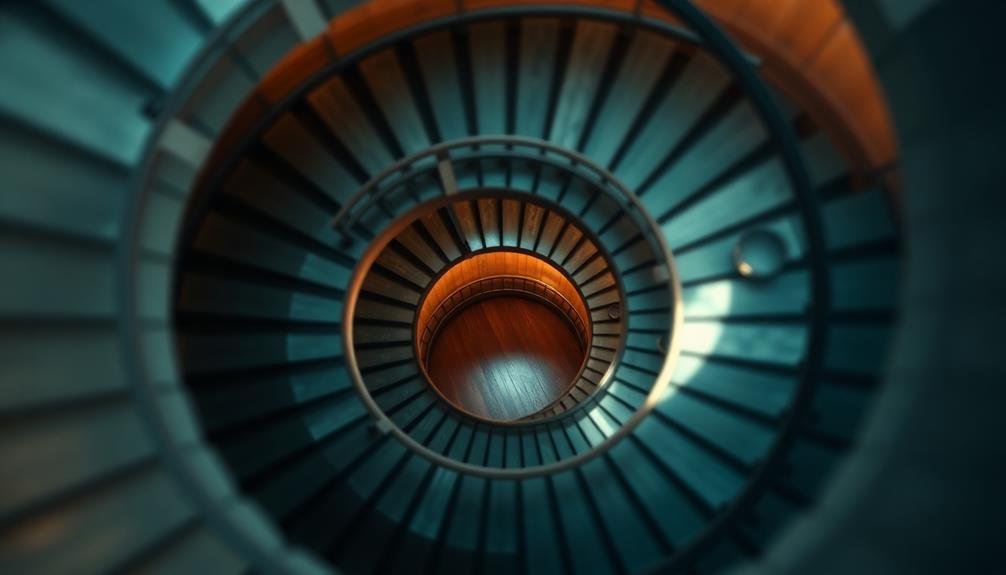
Often overlooked, the Spiral Ascent Dolly Zoom offers a unique twist on the classic vertigo effect.
You'll create this shot by combining a vertical dolly movement with a simultaneous camera zoom and rotation. As you raise the camera on a crane or jib arm, zoom out while rotating the camera in a spiral motion.
To execute this maneuver, you'll need a sturdy crane or jib arm capable of smooth vertical movement. Attach your camera to a fluid head that allows for smooth panning.
Begin with a tight shot of your subject, then slowly ascend while zooming out and rotating the camera. The key is to maintain a consistent speed for all three movements.
This technique creates a disorienting effect that can heighten tension or convey a character's emotional turmoil. It's particularly effective in scenes where a character experiences a sudden realization or faces an overwhelming situation.
You can adjust the intensity by varying the speed of the ascent, zoom, and rotation. Practice this maneuver extensively to achieve seamless coordination between all elements, ensuring a smooth and impactful shot.
Reverse Tracking Shot
While the Spiral Ascent Dolly Zoom creates a disorienting effect, the Reverse Tracking Shot offers a different dynamic. This technique involves moving the camera backward while zooming in on the subject, creating a unique sense of compression and revealing new elements in the frame.
To execute a Reverse Tracking Shot, you'll need a dolly or slider and a zoom lens. Begin by framing your subject in a wide shot, then slowly move the camera backward while simultaneously zooming in. The key is to maintain the subject's size in the frame while the background changes dramatically.
This technique can evoke various emotions and create powerful visual storytelling.
Here are four scenarios where you might use a Reverse Tracking Shot:
- A character walking away from a life-changing decision
- Revealing hidden dangers lurking behind the subject
- Emphasizing a character's isolation in a crowded space
- Shifting from an intimate moment to a broader context
Arc Trajectory Reveal
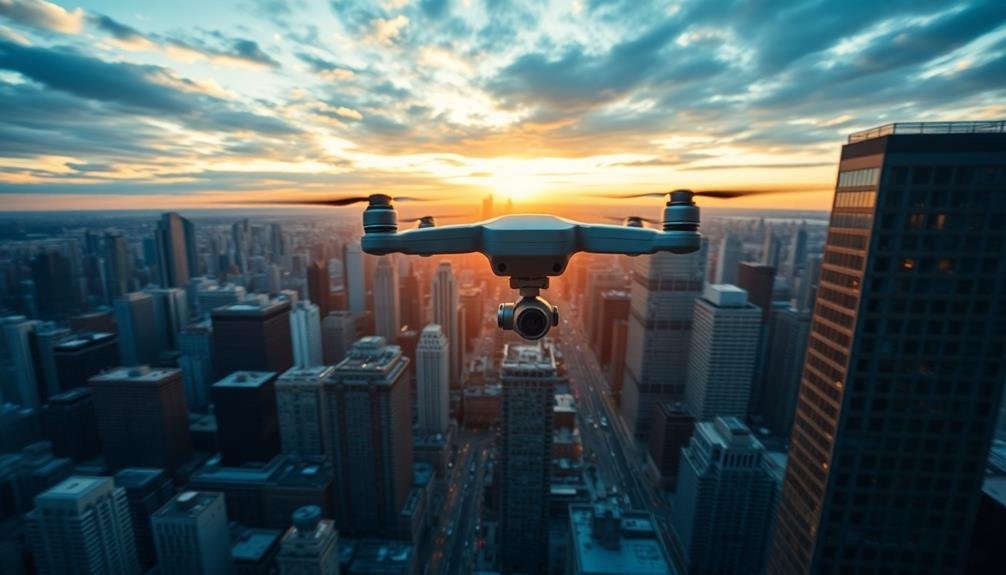
The Arc Trajectory Reveal takes the dolly zoom to new heights by incorporating curved motion. This dynamic technique combines a dolly zoom with a circular camera movement, creating a mesmerizing visual effect that can disorient viewers or emphasize a character's emotional state.
To execute this maneuver, you'll need a curved dolly track or a circular slider. As you move the camera along the arc, simultaneously adjust the zoom to maintain a consistent framing of your subject. The result is a shifting perspective that discloses the background in a sweeping, dramatic fashion.
You can use the Arc Trajectory Reveal to:
- Disclose a hidden object or character
- Shift between scenes
- Emphasize a character's realization or emotional shift
- Create a sense of disorientation or unease
When planning your shot, consider the speed of the camera movement and zoom adjustment. A slower, more subtle reveal can build tension, while a faster execution can startle or surprise your audience.
Experiment with different arc lengths and zoom ranges to find the perfect combination for your scene's emotional impact and narrative purpose.
Sideways Slide Dolly Zoom
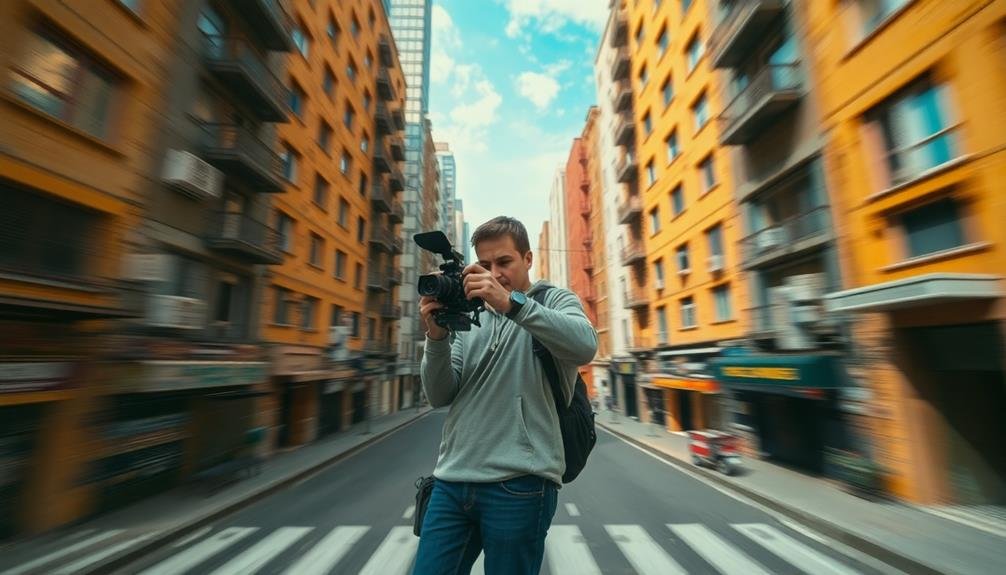
To set up for a sideways slide dolly zoom, you'll need a smooth dolly track or slider and a zoom lens on your camera.
Make certain your subject remains centered in the frame as you move the camera laterally while simultaneously adjusting the zoom.
Practice the timing of your sideways movement and zoom adjustment to achieve the desired disorienting effect smoothly.
Equipment Setup Tips
Setting up for a sideways slide dolly zoom requires careful preparation and the right equipment. You'll need a sturdy dolly or slider, a zoom lens, and a camera with manual focus capabilities. Verify your dolly track is level and smooth to prevent unwanted camera shake. Position your subject perpendicular to the dolly's movement for the best effect.
When setting up your shot, consider these key elements:
- Background: Choose a visually interesting backdrop that'll enhance the distortion effect.
- Lighting: Set up your lights to maintain consistent exposure throughout the zoom.
- Focus: Mark your focus points to maintain sharpness during the maneuver.
- Framing: Plan your start and end compositions carefully.
Practice the move several times before filming. Coordinate your dolly movement with the zoom adjustment, making sure they're in sync.
You'll want to move the camera sideways while simultaneously zooming in or out. Keep your subject centered in the frame throughout the maneuver. Experiment with different speeds and zoom ranges to find the most dramatic effect for your scene.
Executing the Movement
Mastering the sideways slide dolly zoom requires precise coordination and practice. Begin by positioning your camera perpendicular to your subject, ensuring you have enough space to move laterally. Set your focus on the main subject and lock it to maintain sharpness throughout the movement.
As you start the shot, slowly move the dolly sideways while simultaneously adjusting your zoom. For a push-in effect, dolly away from the subject while zooming in. For a pull-out effect, do the opposite. The key is to maintain a consistent speed for both the dolly movement and zoom adjustment.
Keep your subject centered in the frame as you move. This can be challenging, so use markers on the ground to guide your path. Pay attention to your background, as it will dramatically change during the maneuver. Adjust your aperture if necessary to maintain proper exposure as you zoom.
Practice the movement multiple times before recording. Start slowly and gradually increase your speed as you become more comfortable. Remember, the impact of the sideways slide dolly zoom comes from smooth, controlled execution. Don't rush the movement; instead, focus on precision and timing to achieve the desired cinematic effect.
Figure-Eight Pattern
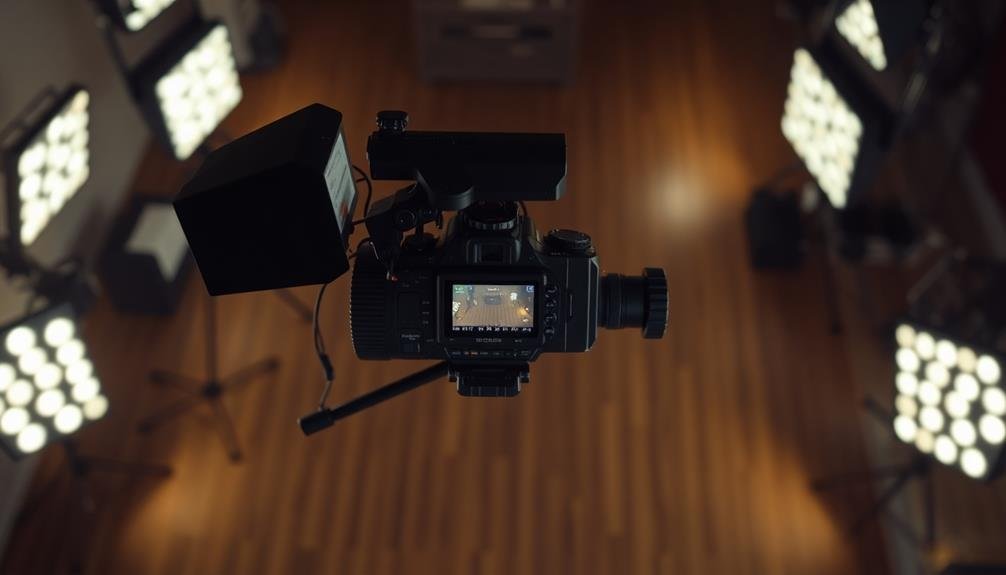
Creativity in camera movement reaches new heights with the figure-eight pattern dolly zoom. This technique combines the disorienting effect of a traditional dolly zoom with a fluid, figure-eight motion. You'll create a mesmerizing visual experience that draws viewers into your scene while simultaneously unsettling them.
To execute this maneuver, you'll need a dolly track or slider set up in a figure-eight configuration. As you move the camera along this path, you'll simultaneously adjust your zoom to maintain the subject's size in the frame. The result is a dynamic shot that changes perspective and depth in a uniquely enchanting way.
Imagine the following scenarios where this technique could enhance your storytelling:
- A character's world spinning out of control during a crisis
- The dizzying effect of a character falling or losing consciousness
- Revealing the scope of a vast landscape or cityscape
- Emphasizing the isolation of a character in a crowded space
Practice this movement extensively before attempting it on set. Smooth, precise execution is essential for achieving the desired effect without nauseating your audience.
Experiment with different speeds and zoom ranges to find the perfect combination for your specific shot.
Perpendicular Crossover Maneuver
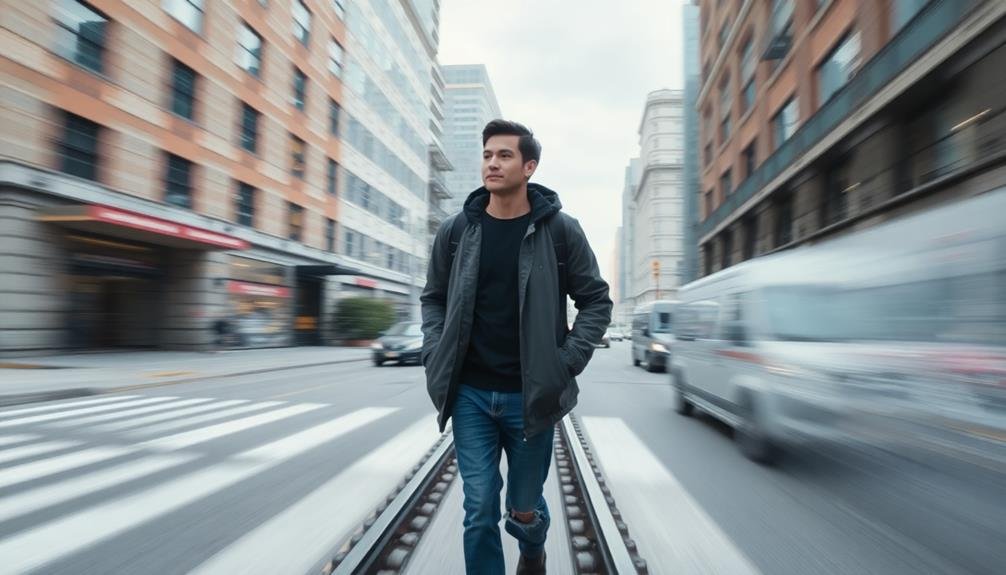
The perpendicular crossover maneuver takes the dolly zoom to new heights of complexity and visual impact.
You'll start by positioning your camera perpendicular to the subject, then move laterally while simultaneously adjusting your zoom and focus. As you move, you'll cross over to the opposite side of the subject, creating a dynamic shift in perspective.
To execute this maneuver, you'll need a smooth dolly track or slider and a lens with a wide zoom range.
Begin with a wide-angle shot and slowly zoom in as you move sideways. Keep your subject centered in the frame throughout the movement. As you cross the midpoint, you'll need to quickly adjust your focus to maintain sharpness.
This technique creates a disorienting effect that can heighten tension or emphasize a character's emotional state. It's particularly effective in cramped spaces or when you want to reveal new elements of the scene gradually.
You can enhance the impact by varying your speed or combining it with a slight tilt. Practice is essential to nail the timing and smoothness required for this advanced dolly zoom technique.
Frequently Asked Questions
What Equipment Is Essential for Executing a Dolly Zoom Effectively?
You'll need a camera with manual zoom, a dolly or slider, and a sturdy tripod. Don't forget a focal length chart and measuring tape. Practice smooth movements and precise timing to nail your dolly zoom shots.
How Do You Maintain Focus During Complex Dolly Zoom Movements?
To maintain focus during complex dolly zoom movements, you'll need to use a follow focus system. Practice smooth adjustments, mark your focus points, and consider using an assistant to help you nail the focus throughout the shot.
Can Dolly Zoom Techniques Be Achieved With Handheld Cameras?
Yes, you can achieve dolly zoom effects with handheld cameras. It's challenging, but with practice, you'll master it. Use stabilizers, walk smoothly, and maintain consistent speed. Focus on your subject while moving to create the signature effect.
What Are Common Mistakes to Avoid When Performing Dolly Zooms?
You'll want to avoid jerky movements, inconsistent zoom speeds, and incorrect focal length adjustments. Don't forget to maintain your subject's size in the frame. Also, be careful not to lose focus during the maneuver.
How Do You Plan and Rehearse Dolly Zoom Shots for Optimal Results?
You'll want to scout your location, mark your camera positions, and practice the move repeatedly. Coordinate with your subject, refine your timing, and adjust your zoom speed. Test different focal lengths to find the most impactful result.
In Summary
You've now got a powerful toolkit of dolly zoom techniques to elevate your cinematography. Remember, practice makes perfect. Don't be afraid to experiment and combine these maneuvers for unique effects. As you master these moves, you'll create visually striking scenes that captivate your audience. Keep pushing your creative boundaries, and you'll soon find yourself crafting unforgettable cinematic moments that leave viewers in awe of your technical skill and artistic vision.

As educators and advocates for responsible drone use, we’re committed to sharing our knowledge and expertise with aspiring aerial photographers.
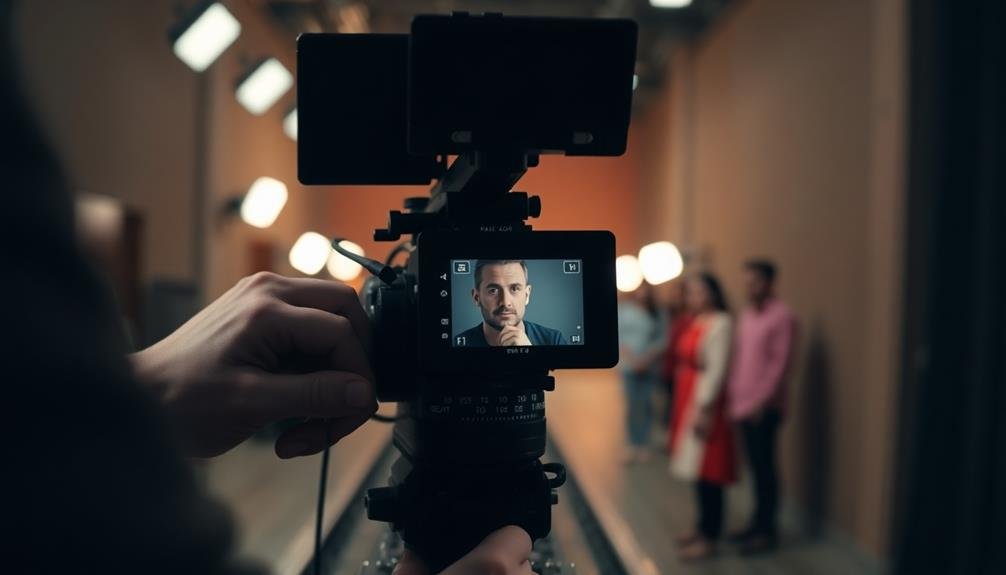



Leave a Reply